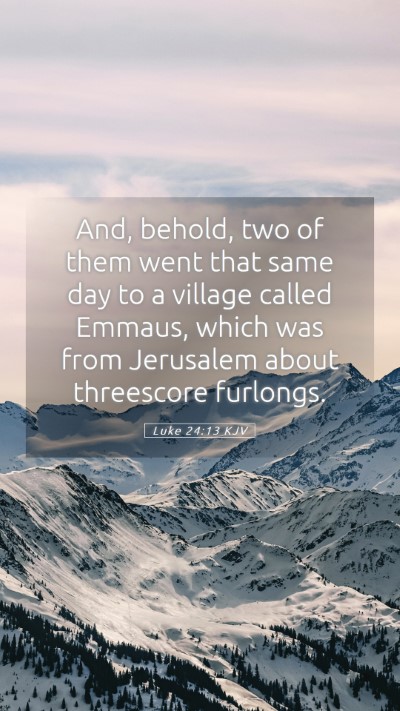Understanding Luke 24:13
Luke 24:13 narrates the story of two disciples walking to a village called Emmaus on the day of Jesus' resurrection. This passage is significant as it depicts the theme of searching for understanding and revelation in the aftermath of Christ’s death and resurrection. Below, we explore the deep meanings and interpretations of this verse, pulling insights from various public domain commentaries including those by Matthew Henry, Albert Barnes, and Adam Clarke.
Verse Context
Luke 24:13 states:
“And, behold, two of them went that same day to a village called Emmaus, which was from Jerusalem about threescore furlongs.”
Comprehensive Analysis
The journey to Emmaus symbolizes a search for clarity and understanding after a time of confusion and grief. The disciples were disheartened by the recent events surrounding Jesus’ crucifixion. Their movement toward Emmaus indicates a desire to return to normalcy, away from the tumultuous events in Jerusalem.
Meaning from Matthew Henry
Matthew Henry emphasizes the importance of companionship in moments of despair. The two disciples' conversation serves to highlight how sharing grief and confusion can lead to deeper insights and revelations. Henry suggests that in their discussion of Christ's death and the reports of His resurrection, they were unknowingly preparing themselves for a significant spiritual encounter.
Insights from Albert Barnes
Albert Barnes notes the geographical significance of Emmaus. Referencing its distance from Jerusalem, he interprets the act of leaving the city as a physical and emotional retreat for the disciples. Barnes underlines the theme of Restoration, as this journey ultimately leads to a newfound understanding of Jesus’s role as the Messiah, despite their initial despair.
Adam Clarke's Commentary
Adam Clarke provides a detailed analysis of the historical and cultural context of the time, indicating that the disciples were grappling with the unexpected nature of Jesus’ ministry and death. He elaborates on the prophetic implications surrounding the events and how they foreshadowed Christ’s ultimate victory over death. Clarke suggests that this walk to Emmaus serves as a metaphor for many believers’ journeys from doubt to deeper faith.
Thematic Significance
This verse encapsulates several significant themes in biblical study, including:
- Discipleship: The importance of community and sharing experiences.
- Revelation: How God reveals Himself through ordinary circumstances.
- Hope in Darkness: The nourishment of faith even amid confusion and struggle.
Practical Applications
When applying the insights from Luke 24:13 to daily life, believers can find solace in their own journeys through doubt and confusion. It encourages engaging with others in conversation about their faith, as this can lead to profound revelations.
Connecting with Modern-Day Believers
This passage can be especially relevant for:
- Those participating in Bible study groups, who seek to understand scripture in a communal setting.
- Individuals engaging in online Bible study, seeking resources to grasp difficult passages.
- Those exploring Bible study lessons focusing on the theme of revelation.
Cross References
For a deeper understanding, consider the following related verses:
- John 20:14-18: Jesus’ appearance to Mary Magdalene post-resurrection.
- Luke 24:30-31: The break of bread that leads to the disciples’ recognition of Jesus.
- Isaiah 53:5: The prophecy about the suffering servant which resonates with their initial despair.
Conclusion
In conclusion, Luke 24:13 invites believers to explore the depths of their own faith journeys and emphasizes the importance of community in seeking understanding. Drawing from the commentaries of Henry, Barnes, and Clarke, one can appreciate the transformative power of shared experiences and divine revelation found in scripture. This passage serves as a reminder that in times of uncertainty, clarity can emerge through conversation, reflection, and faith in Christ’s resurrection.


